Last Updated on July 17, 2023
There are a lot of different methods that parents use to get their babies to sleep. Some parents rock their babies to sleep. Others put them in a crib and let them fall asleep on their own.
One method that is becoming more and more popular is letting the baby fall asleep in a swing. It is gentle, soothing and one of the most popular ways to put a baby to sleep. But can a baby sleep in a swing all night?
The answer to that question depends on several factors, including the age of your child and how well they sleep in other settings. In this blog post, we’ll discuss can a baby sleep in a swing all night and the pros and cons of allowing your baby to sleep in their swing overnight.
We will also provide some tips for ensuring that your child gets a good night’s sleep. So, keep reading!
- Can baby sleep in swing all night?
- Is it safe for baby to sleep in swing?
- Why Aren't Baby Swings Safe for Sleep?
- What if baby falls asleep in swing?
- Why Babies Should Sleep on a Flat Surface?
- Can Baby Nap in the Infant Swing?
- Can a baby get SIDS from sleeping in a swing?
- How Serious Is the Risk?
- Why does SIDS peak at 2-4 months?
- Are swings bad for babies?
- How to break the baby's habit of sleeping in a swing?
- FAQ
- The Takeaway
Can baby sleep in swing all night?
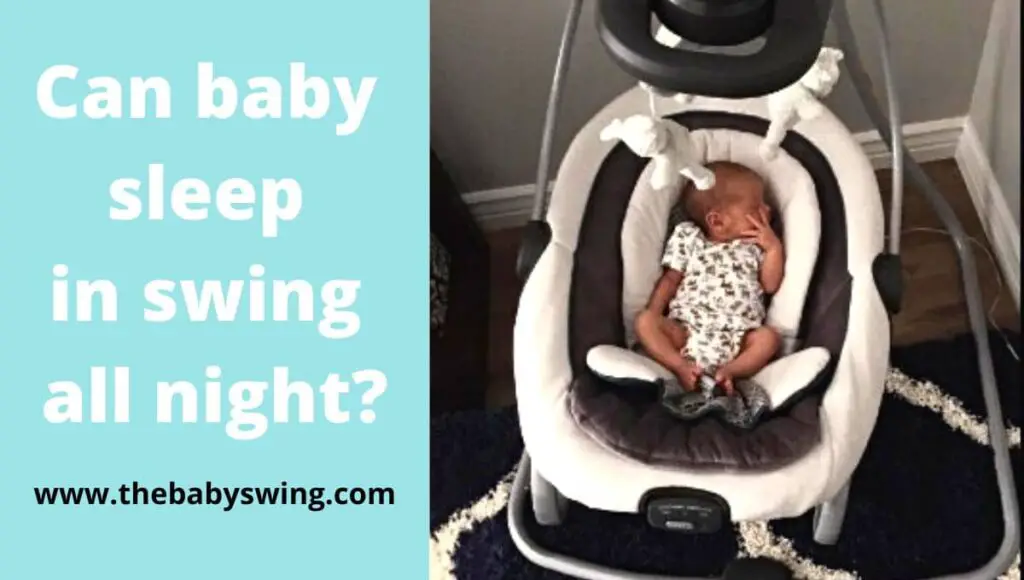
A catnap under your watch is fine, but your baby shouldn’t sleep in the swing all night or while you’re asleep. The swing’s motion may frequently put infants to sleep.
While a swing might appear relaxing, experts have warned that it is dangerous for infants to remain asleep in this posture.
The American Academy of Pediatrics (AAP) advises transferring your baby from the swing to a safe sleeping place if they fall asleep in the swing.
There are many dangers associated with letting your baby sleep in a swing all night. The AAP warns that “infants should never be left unattended in a swing, because they can slip out of the seat and become entrapped or strangle.”
Plus, babies can suffer from head injuries if they fall asleep in a swing and are not properly secured. In addition, the constant motion of the swing can lead to Sudden Infant Death Syndrome (SIDS).
If you choose to let your baby nap in a swing, stay close by and never leave them unattended.
Another danger of letting your baby sleep in a swing all night is that they could develop the flat head syndrome. This condition is caused by spending too much time lying on their back with their head in the same position. The pressure on the back of the head can cause a flat spot to form.
If you are worried about your baby’s sleep, talk to your pediatrician. They can help you create a safe sleep environment for your baby and give you peace of mind.
Is it safe for baby to sleep in swing?
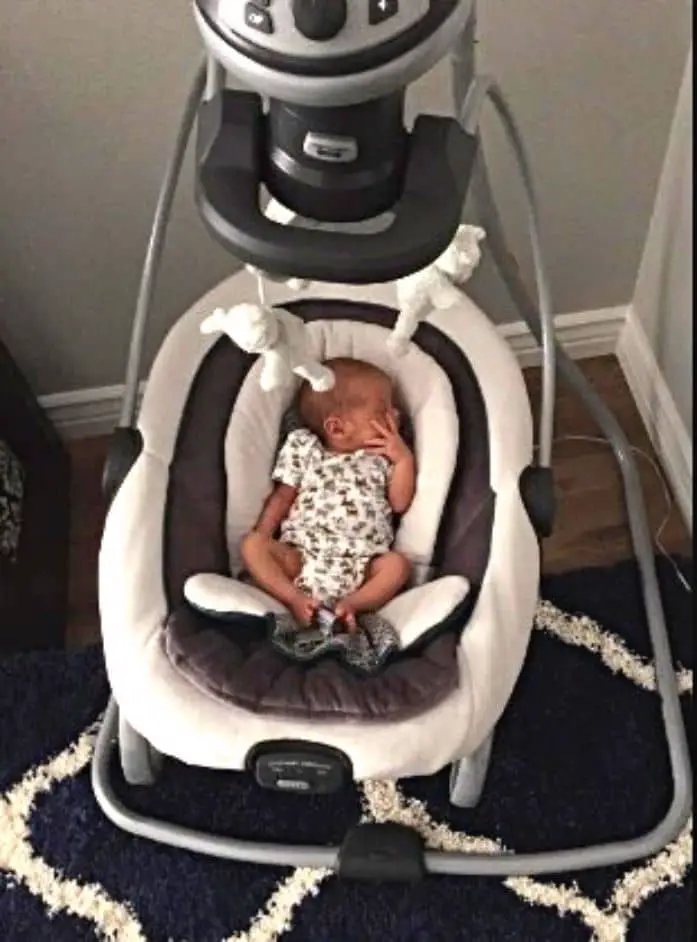
You can put the baby in the swing when they are awake, and the swing is not being used excessively and the baby is supervised while in the swing.
For example, when you want to take some time for your work, it can be a blessing for you at that time. The motion of the swing can keep the baby peaceful and relaxing.
But you can’t let the baby sleep in the swing. The American Academy of Pediatrics (AAP) states that infant swings should not be used for sleep. “Babies should sleep on their backs on firm, flat surfaces,” Sneed added. “SIDS is more likely when a baby isn’t sleeping on a firm, flat surface.”
However, it is important to note that a baby should not be left unattended in the swing and always be put to sleep on their back to reduce the risk of Sudden Infant Death Syndrome (SIDS).
Related Read: What age to use baby swing
Why Aren’t Baby Swings Safe for Sleep?
There are a few reasons why baby swings are not considered safe for sleep.
- Baby swings can cause babies to become overstimulated, which can lead to difficulty falling asleep.
- Baby swings can increase the risk of Sudden Infant Death Syndrome (SIDS) by creating a “rebreathing” hazard. When a baby is in a swing, their head can fall forward into the seat, causing them to rebreathe their own exhaled air. This can lead to carbon dioxide poisoning and potentially death.
- Their necks aren’t completely developed, so sleeping at a semi-upright angle might apply pressure to the infant’s necks and cause them to slump over. This slumping can sometimes result in suffocation.
- Swings can be dangerous if they are not used properly. If a baby swing is not securely fastened to the frame of the swing, it can tip over and cause serious injury.
For these reasons, it is important always to follow the manufacturer’s instructions when using a baby swing.
What if baby falls asleep in swing?
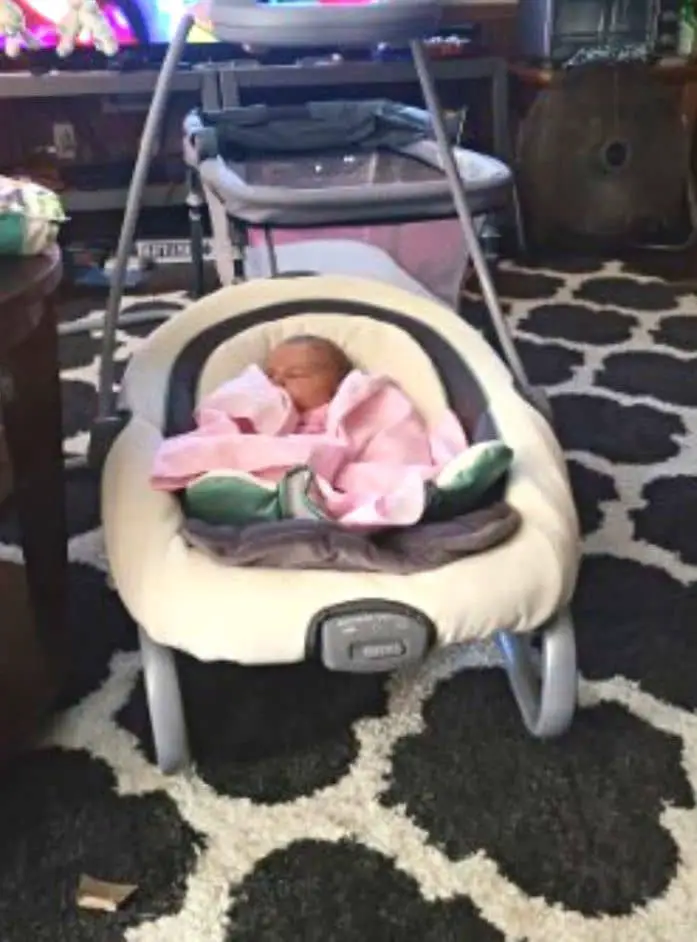
Swings are a necessary thing for the parents of infants. The baby can feel sleepy with the rocking motion of the swing.
When a baby falls asleep in an upright posture in the swing, the weight of their head might cause it to drop forward. In some situations, it may cut off the oxygen flow, resulting in suffocation.
That’s why babies require a firm, flat surface to sleep safely.
If the baby falls asleep in a swing, you should transfer them to a crib or another flat surface. Be sure to do so gently so as not to wake them up. And it must be noted that you move them on their back so that they can sleep safely.
Why Babies Should Sleep on a Flat Surface?
Most babies sleep on a flat surface, such as in a crib or bassinet. This is because it is the safest way for them to sleep. Sleeping on a flat and firm surface reduces the risk of Sudden Infant Death Syndrome (SIDS) rates and is also recommended by the American Academy of Pediatrics (AAP).
There are several reasons why sleeping on a flat surface is important for babies.
- First, it helps to prevent SIDS. SIDS is the leading cause of death for infants under one year old, and most cases occur when babies are between two and four months old. Sleeping on a flat surface decreases the risk of SIDS.
- Second, sleeping on a flat surface helps to prevent other sleep-related problems, such as suffocation, entrapment, and strangulation. All of these are potentially fatal. And also, it keeps the baby warm.
- Third, sleeping on a flat surface promotes healthy development. Babies who sleep on their backs get the benefits of gravity, which helps them correctly align their spine and head. This promotes proper development of the neck and head muscles and can help prevent flattening of the back of the head (plagiocephaly).
- Finally, sleeping on a flat surface is just more comfortable for babies. They can move around freely and don’t have to worry about their head being in an uncomfortable position.
Related Read: Can a baby swing go too fast
Can Baby Nap in the Infant Swing?
It’s fine for a catnap to happen under your watch, but it’s not safe for your child to sleep in a swing. Infants haven’t yet developed the strength in their muscles to keep their heads up. They might slump their head forward if they are not in a reclined position when they fall asleep, even if it is only for a nap, which can block the oxygen flow. It is better to place your child down for a nap in a safe crib.
When it comes to naps, it is important that you create a safe and comfortable environment for your child. This means having a designated space where your child can sleep without interruption. It should be dark, quiet, and cool in the room.
You might want to invest in a white noise machine to help your child fall asleep and stay asleep. A swing is not an ideal space for a nap because it is not a stationary surface.
Your child could easily roll out of the swing or tip it over if they move around too much. It is also difficult to keep the swing at a consistent level of comfort throughout the nap. If your child falls asleep in the swing, it is best to transfer them to a crib or bassinet as soon as possible.
The American Academy of Pediatrics (AAP) recommends that if your baby falls asleep in the swing, you should take them from the swing to a secure sleeping location.
Can a baby get SIDS from sleeping in a swing?
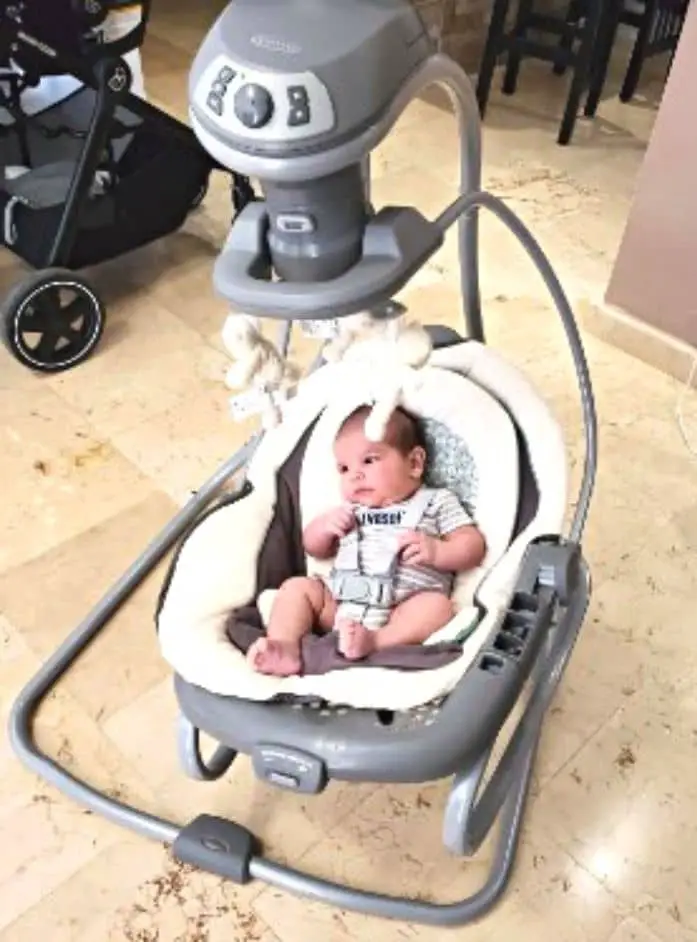
Sudden infant death syndrome (SIDS) is the unexpected death, generally during sleep, of a seemingly healthy baby under a year old who appears to be healthy.
According to the American Academy of Pediatrics (AAP), putting a baby in a bouncy seat, baby swing, or carrier to sleep for their first year of life puts the infant at significant risk.
The AAP urges parents to avoid using them as sleep surfaces for babies due to the potential risks. The safest place for an infant to sleep is on a firm, flat surface in their own crib or bassinet on their backs.
How Serious Is the Risk?
Although this statistic may appear frightening, SIDS is uncommon, and the danger of your infant dying from it is quite low. The majority of deaths occur during the first six months of a baby’s life. Infants who are born prematurely or have a low birthweight are at greater risk. SIDS also appears to be somewhat more common in male infants.
According to an AAP study, hundreds of newborn babies die each year while sleeping in devices intended for sitting. This includes swings, baby carriers, automobile seats, strollers, and bouncy chairs.
Why does SIDS peak at 2-4 months?
A theory suggests that the cardiorespiratory system of all infants is in rapid development and therefore unpredictable. Infants in this age range are vulnerable to respiratory control failure, which could lead to sudden death.
Plus, babies are starting to become more mobile at this age and are also beginning to develop their own sleep patterns. This can lead to them sleeping in positions that are not ideal for their breathing, which may contribute to SIDS.
Additionally, 2-4 months is around the time when babies start to explore their environment more, and they may be more likely to put objects in their mouths. This increases the risk of them inhaling something that could block their airway and lead to SIDS.
Finally, this age range is when cold and flu season typically occurs, and infants are more susceptible to these illnesses. This may also play a role in the increase in SIDS cases during this time.
Are swings bad for babies?
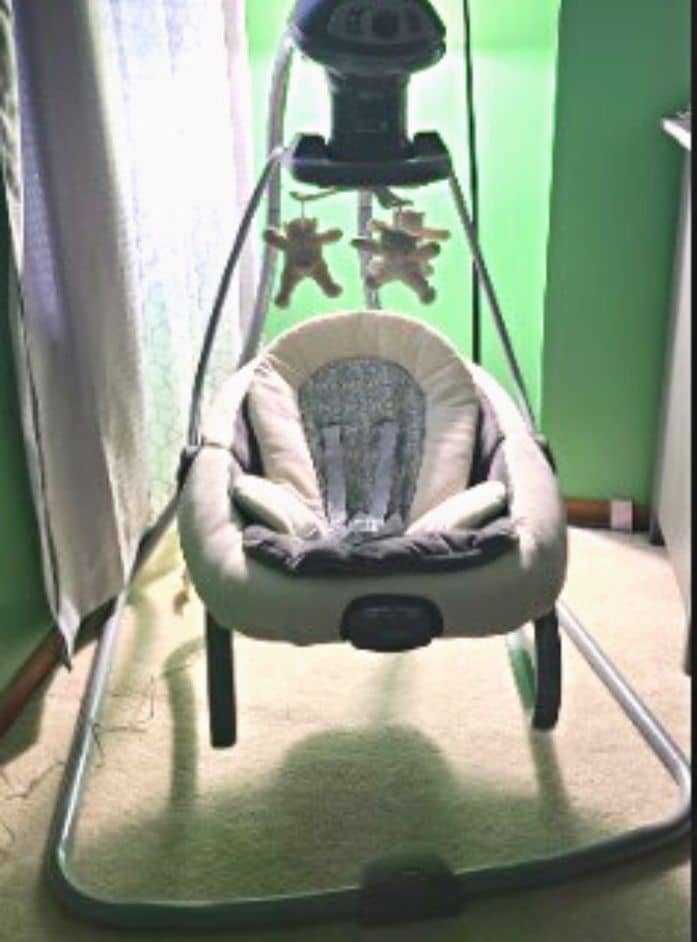
Baby swings are an excellent tool for keeping your infant occupied, but misusing them may be dangerous. The swing’s motion may frequently lull infants to sleep. While infants may appear calm and comfortable while sleeping in a swing, safe sleep experts warn that allowing them to do so is extremely dangerous.
Sleeping in an upright position like a baby swing can increase an infant’s risk of suffocation and Sudden Infant Death Syndrome (SIDS). The American Academy of Pediatrics (AAP) recommends that babies be placed on their backs to sleep, even for naps.
If you do decide to use a baby swing, the AAP offers the following safety tips:
1. Always use the swing in an upright position. Baby swings are not meant for sleeping babies – they should be used in an upright position only.
2. Never leave your beloved baby unattended in the swing. Even if you are just stepping away for a minute, you should move the baby to a crib from the swing.
3. Make sure the swing is on a level surface. Baby swings should always be used on a level surface to prevent tipping or rocking.
4. Use the swing for short periods of time only. Baby swings are not meant for extended use – limit your baby’s time in the swing to 20 minutes or less.
5. Always use the safety straps. Most baby swings come with built-in safety straps – be sure to use them every time your baby is in the swing.
By following these simple tips and safety precautions, you can help ensure that your baby has a safe and enjoyable experience when using a baby swing.
How to break the baby’s habit of sleeping in a swing?
If your baby has developed a habit of sleeping in a swing, it may be difficult to break. However, it is possible to break the habit by slowly transitioning your baby to sleep in other places.
– Start by putting your baby down for naps in a crib or bassinet. If your baby cries, try rocking or patting them until they fall asleep.
– At night, put your baby in their crib or bassinet and stay with them until they fall asleep. You may need to do this for several nights before your baby gets used to sleeping without the swing.
– To make the atmosphere as sleep-friendly as possible, use a white noise machine or a fan and room-darkening curtains.
– Keep your baby’s swing in a busy, well-lit, and loud environment during the day, reframing it as a location where activities occur. This will teach your infant that the swing is for playing rather than sleeping.
FAQ
The Takeaway
Swinging can be a fun and relaxing activity for both baby and parent. However, it is important to follow safe sleep practices when using a swing. Be sure to place your baby in a crib or bassinet when they are sleeping, and use room-darkening curtains and white noise to create a sleep-friendly environment.
We hope you’ve found this article helpful. If you have any questions or concerns about safe sleep practices, be sure to talk to your child’s doctor.
Resources:
- https://www.healthline.com/health/baby/sleeping-in-baby-swing
- https://www.today.com/parents/babies-sleeping-swings-it-safe-practice-t190128
- https://www.verywellfamily.com/can-babies-sleep-in-a-baby-swing-5100896
- https://www.cnet.com/health/parenting/how-to-break-your-babys-habit-of-sleeping-in-a-swing/

Amy A. Vincent is a Certified Pediatric Sleep Consultant and a mother of three beautiful children. She helps parents transition their babies from swing sleep to safe, independent sleep. She is passionate about helping parents teach their children the skills needed to become good sleepers and aims to make the process as easy and stress-free as possible. Read more
